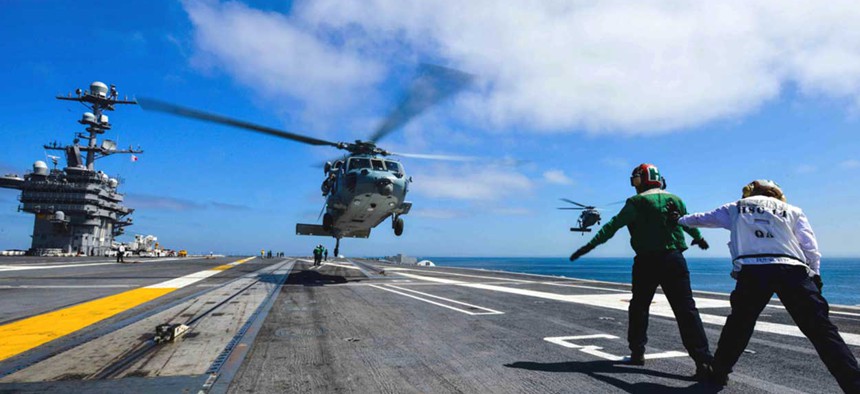
A couple of Navy enlisted personnel direct an MH-60S Knight Hawk helicopter as it prepares to land aboard the USS John C. Stennis. U.S. Navy photo by Petty Officer 3rd Class Ignacio D. Perez
How the Military Can Reinforce the Pivot to Asia
A broader investment in technology and innovation can create the necessary edge to win future battles in the Pacific.
The Council on Foreign Relations’ newly released Council Special Report, Revising U.S. Grand Strategy Toward China,proposes a new approach to address the challenges and potential dangers posed by China’s economic, diplomatic and military expansion. The new, proactive approach from Ambassador Robert D. Blackwill and Dr. Ashley J. Tellis moves beyond old models based simply on integration and engagement. The military element of the recommended grand strategy calls for significant investment in “Capabilities and capacity specifically to defeat China’s emerging anti-access capabilities and permit successful U.S. power projection even against concerted opposition from Beijing.”
Several efforts are underway in Washington that could help achieve these military recommendations. The two most important are the Defense Innovation Initiative, often referred to as the “third offset strategy,” and the ongoing deliberations regarding the FY16 defense budget proposed by President Obama last month.
The Defense Innovation Initiative was announced in November 2014 by former Secretary of Defense Chuck Hagel, intended to sustain and advance U.S. military superiority in the twenty-first century. Three specific elements in the initiative directly support the military component of the China strategy proposed by Blackwill and Tellis.
First, a long-range research and development program will identify, develop and field breakthrough technologies and systems. New technologies and systems will be critical to offset China’s ongoing military growth and modernization efforts. New technology is also needed to reverse the erosion of U.S. technological superiority, particularly in areas related to space, cyber, missile defense and undersea warfare.
Second, the Defense Innovation Initiative calls for a reinvigorated wargaming effort to find new ways of achieving strategic objectives and improve U.S thinking on the future security environment. Wargaming is critically important to develop and assess the capabilities needed to overcome China’s expanding anti-access/area denial (A2/AD) programs. These A2/AD programs are designed to disrupt the ability of the U.S. to project power into the western Pacific and include things like cruise missiles, anti-air systems, anti-ship missiles, mines and cyber weapons.
Wargaming also supports the development of the third element in the Defense Innovation Initiative that can be applied to a U.S. military strategy for China—developing new operational concepts for employing resources to greater strategic effect. Wargaming will help American military planners test new models for U.S. force laydown in East Asia to facilitate a more consistent and operationally effective presence. Wargaming will also allow military planners to develop new methods of employing U.S. forces that could deter future aggressive action from China’s military. The concept of “archipelagic defense” described by Andrew F. Krepinevich in the March/April 2015 edition of Foreign Affairs is an example of the creative thinking needed to develop methods of employing U.S. and allied military forces to preserve stability in the Asia-Pacific region.
While the Defense Innovation Initiative is important to achieve many of the military recommendations contained in the newest CSR on U.S. grand strategy for China, the 2016 budget deliberations are even more important. The 2016 budget submitted to Congress by President Obama reverses recent declines in defense spending. It contains the resources to continue the Department of Defense’s rebalance to the Asia-Pacific region and makes significant investments in nuclear deterrence, space control, power projection, missile defense and cyber warfare. These long-term investments will help maintain the force structure needed for the forward presence of the United States in East Asia while also protecting U.S. technological superiority in spite of China’s unprecedented military investment and growth.
Although there appears to be broad support in Congress for increasing the size of the military budget, there is no consensus yet on where to find these additional funds. The problem with strategy and budgets in times of limited resources is that American policymakers could be forced to prioritize funding between competing requirements such as the immediate fight against ISIS and long-term, but potentially more dangerous, challenges like a rising China.
As leaders in Washington attempt to resolve near and long-term budget requirements, the United States would be well served to consider those Chinese policy objectives identified by Blackwill and Tellis: to fundamentally alter the balance of power in Asia, to undermine the U.S. alliance system and to replace the United States as the leading power in Asia. If these objectives were achieved by China, the damage done to American interests would be far greater than the damage ISIS is capable of inflicting on the United States.
Nobody wants a military confrontation with China—the consequences would be catastrophic for the entire world and could include a nuclear exchange. An effective American strategy for maintaining the balance of power in Asia and avoiding a fight with China must combine diplomacy with military deterrence. Long-term defense investment for many budget cycles is needed to develop and maintain the military capabilities to address the security challenge from China. Without adequate resources, the sound policy prescriptions and recommendations contained in Revising U.S. Grand Strategy Toward China are nothing more than wistful thinking.
This post appears courtesy of CFR.org.



